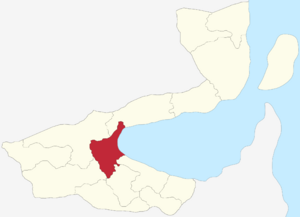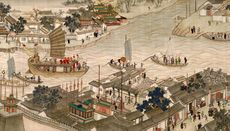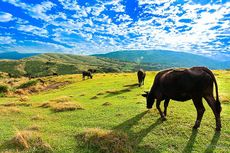Bazhong
Caution: Incomplete Article This article is incomplete by choice. More content will be added to it soon! |
Bazhong 巴中州 Bāzhōng zhōu | |
|---|---|
 Map of Monsilva with Bazhong highlighted | |
| Country | |
| State status | 3 June 1983 |
| Capital | Waiping (外坪) |
| Government | |
| • Body | Bazhong State Government |
| • State Minister | Yu Mei (FDP) |
| Population (July 2022) | |
| • Total | 2,307,169 |
| Time zone | AMT-12 (Monsilvan Standard Time, MST) |
| ISO 3166 code | MS-BAZ |
| GRP (M¥) | M¥456 billion |
| Major airports | Waiping City Airport (WPY) |
| Transit System(s) | MRA Waiping Tram (Waiping only) |
| Police[1] | Bazhong State Police |
| Ambulance[2] | Bazhong State Ambulance |
| Fire[3] | Bazhong Fire Service |
Bazhong (Monsilvan: 巴中州; Pinyin: Bāzhōng zhōu), is a state of the Monsilvan Republic. The state has around 2.3 million people, with 63% of them living in the state's capital, Waiping. It is located in central Monsilva, sitting north of Amking, south of Xiaogu and east of Weishi and Xishanjia. Bazhong is has a warm climate and has good soil quality, encouraging increased urbanization along its coastline in the east, and agriculture land dominating the west of the state. The state of Bazhong is governed by the Bazhong State Government, with Yu Mei of the Freedom and Democracy Party being the current state minister. The state is divided into 3 districts, 12 counties and 39 municipalities and is equally represented by 3 Senators in the Senate and 12 members in the Legislative Assembly. The Bazhong State Parliament consists of 39 seats, and is currently lead by the Freedom and Democracy Party, with the RNP/PNP coalition leading the opposition.
Bazhong is Monsilva's 8th most populous state, and has the 5th highest urbanization of all the states, which is unsually high for a state with a state which a much lower population. In terms of industry, rural Bazhong leads Monsilva in cow-related products, including leather, milk and meat. In urban Bazhong, the capital Waiping is a common tourist destination for tourists wanting Monsilvan seaside culture, without the crowds and usual city noise pollution one might find in Amking or Luhai. Menggu is Bazhong's only city other than the capital and has a population of just over 580k people. Menggu is isolated from the rest of Bazhong by towering hills, which has made an obvious contrast in culture between it and the rest of the state. Bazhong has a nominal GRP of around ₵76 billion, giving it a GRP per capita of ₵32,749.
Bazhong is connected by the Monsilvan Railways Administration, which provides services throughout the state. Waiping, as well as having the MRA, is also served by the Waiping Tram System. Bazhong has one international airport: Waiping City Airport. A high-speed rail running from cities in north, west and southern Monsilva runs through Bazhong and stops at Waiping Main Station. Public transport is not as common in Bazhong as it is in many other states, so highways and country roads running through the state can get busy.
Contents
Toponymy
The name, 'Bazhong comes directly from the HY Pinyin of the Monsilvan "巴中". As with most Monsilvan states, the name has an archaic origin which is often debated. However, what is known is that the individual characters have meaning. In modern Monsilvan, "巴" is often used as a suffix, however it can also have meanings of "hope" and "wishfullness". Whilst the "中" can be translated as "middle" or "central". The name Bazhong, could therefore mean "Middle Hope" or something similar.
History
Prehistory
The region which is now known as Bazhong has been inhabited for thousands of years. Before the establishment of any Monsilvan dynasties, the region of Bazhong was largely untouched by humans and was roamed upon by wildlife. However, eventually, humans reached the coast of Bazhong, where the first settlements in Bazhong began.
Early dynasties

Bazhong as it is today, was entirely under the authority of the Xia dynasty when it was established in 820 BCE. It was predominantly used as agricultural land for growing crops and managing farm animals. Bazhong had no major settlements and was only covered in many small farming towns for most of Monsilva's dynastic history. As Bazhong layed on the boundary region of the Xia dynasty for many years, the region was often subjected to warfare and the land and towns suffered from it. The hills in the south, and the towns on the coast were often used as a buffer by the emperor to prevent invaders reaching Amking.
When the Xia dynasty was defeated by the Han dynasty in 618 CE, Bazhong became no longer a buffer state, and was able to grow in population. By the end of the century, a settlement resembling modern Waiping formed and became the first major settlement in the state.
Zhou dynasty
When the Unification of the Monsilvan Kingdoms took place in 1201, Bazhong was returned from a hybrid of market and agriculture to a purely agricultural region. Large towns in Bazhong suffered, as the population departed for bigger towns in the rest of the country. The Zhou dynasty neglected the Bazhong region for many years, until the explosion of the merchant industry, and the benefits of Bazhong being a coastal region became clear. Bazhong's agriculture became much more important for the country, and the region got much needed attention.
However, the resurgence of life in Bazhong only survived until the late 15th century. In the late 1400s, the Zhou dynasty began to suffer from an unbalanced economy focused too much on selling and not enough buying. Quickly, Bazhong, along with the rest of the country began to suffer economically.
Empire of Baltanla and the Great Shan
When the Zhou dynasty voluntarily ceded itself to the Empire of Baltanla, the country was hopeful that the empire would bring it prosperity. Fortunately, after a few years under the Empire, Bazhong, along with the rest of the country began a slow but steady recovery. Bazhong retained its status as an agricultural state under the empire, and continued to provide merchants with trade in the shadows of Amking and Zhangye's ports.
When Monsilva left the empire in 1730, Bazhong was in much better shape than how it had entered. It retained its position in the country's economy throughout the Kingdom of Great Shan
Monsilvan Civil War
When the Monsilvan Civil War inevitably arrived in 1824, Bazhong became a buffer for warring factions once again, after 1,200 years. Bazhong suffered massively from the war, with towns and villages being frequently subject to raids and arson. Massacre of animals was also frequent within Bazhong and lead to a significant famine in southern Monsilva. The Battle for Waiping is one of the bloodiest that took place within the war, resulting in the most number of troops affected, and second only to the conclusive Battle of Amking in number of deaths.
Kingdom of Monsilva
After the war, Bazhong was in a terrible state. But, after many years of repairs and funding by the Kingdom of Monsilva, it eventually returned. The return of agriculture in the state was expected, but the complete rebuild of Bazhong had lead to more ambitious architecture, which attracted domestic tourism. This allowed Bazhong's economy to grow as a region and more money was funded into making Bazhong tourist friendly. By the end of the 1920s, Waiping, along with other towns along the coast became popular destinations, featuring many resorts and attractions.
Monsilvan Republic
Little changed to Bazhong immediately after the establishment of the Monsilvan Republic. However, this changed when Bazhong was given federal devolution in 1983. This lead to the establishment of the Bazhong State Government as the state's new devolved government. The government has been a contested state, with the RNP and the FDP often fighting over leadership of the government. Although, in recent years, the Liberal Party of Monsilva has seen a gradual growth in seats, and, according to recent polls, is predicted to become the second largest party in the Bazhong State Parliament in the 2024 local elections.
Administration
Local government
National government
Geography
Climate
Demography
| Country of Birth | Population | Percent | |
|---|---|---|---|
| 0 | 0.0 | ||
| Non-Monsilvan | 0 | 0.0 | |
| 23x15px Fujikuni | 0 | 0 | |
| 0 | 0 | ||
| 0 | 0 | ||
| 0 | 0 | ||
| Others | 0 | 0 | |
| Total | 11,535,841 | 100.0 | |

